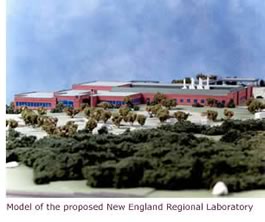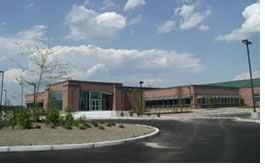
 The
following comes from the General Services Administration's just released
"Best Practices Special Edition: News and Views on Real Property
and Workplace Policy," Fall 2002, which summarizes best practices
offered by candidates for the 2002 GSA Achievement Award for Real Property
Innovation. This example tells how the GSA was able to deliver "Customer
Satisfaction through Sustainability" to its client, the Environmental
Protection Agency, via a new laboratory building in Chelmsford, Mass.
The
following comes from the General Services Administration's just released
"Best Practices Special Edition: News and Views on Real Property
and Workplace Policy," Fall 2002, which summarizes best practices
offered by candidates for the 2002 GSA Achievement Award for Real Property
Innovation. This example tells how the GSA was able to deliver "Customer
Satisfaction through Sustainability" to its client, the Environmental
Protection Agency, via a new laboratory building in Chelmsford, Mass.
The U.S. General Services Administration Public Building Services delivered
a major "green" facility to the Environmental Protection Agency
to satisfy its customer's needs and champion sustainable development.
This successful partnership provided a facility that meets three major
criteria set out by the customer:
• Construct a facility that is functional for its users
• Build a safe facility
• Create a facility as environmentally responsible or "green"
as possible while adhering to the principals of life-cycle costing.
 Green
in this context is defined as a building that uses the best available
materials and technologies to minimize consumption of energy and resources
while maximizing the use of natural, recycled, and non-toxic materials.
The EPA Laboratory in Chelmsford, Mass., is such a building. With some
radical rethinking after the developer was selected, the laboratory now
incorporates the following environmentally friendly features:
Green
in this context is defined as a building that uses the best available
materials and technologies to minimize consumption of energy and resources
while maximizing the use of natural, recycled, and non-toxic materials.
The EPA Laboratory in Chelmsford, Mass., is such a building. With some
radical rethinking after the developer was selected, the laboratory now
incorporates the following environmentally friendly features:
• Energy efficiency
• Water efficiency
• Solar power
• Green power (wind produced)
• Xeriscaping (quality landscaping that conserves water and protects
the environment)
• Modular boilers
• Low volatile organic compounds materials and finishes
• Materials containing post consumer recycled content
• Construction waste management
• An alternative-fuel vehicle fueling station.
 The
move into the facility was conducted in an environmentally respectful
manner using recyclable totes and packing materials made from recycled
products. Since occupancy, a concerted effort at educational outreach
to the design and construction communities and local educational institutions
has taken place. In addition the experience has been shared with other
New England federal property managing entities.
The
move into the facility was conducted in an environmentally respectful
manner using recyclable totes and packing materials made from recycled
products. Since occupancy, a concerted effort at educational outreach
to the design and construction communities and local educational institutions
has taken place. In addition the experience has been shared with other
New England federal property managing entities.
EPA and GSA accomplished this by rethinking the project after developer selection to incorporate Leadership in Energy and Environmental Design (LEED™), a certification program sponsored by the United States Green Building Council. GSA procured in a very short time frame the services of a sustainable consultant and drew on the knowledge of the local utility providers as to efficiencies recommended. The GSA project manager and leasing officer encouraged partnering with the developer, general contractor, and its subcontractors. They sought alternative financing for the photovoltaic sunshade installation from the GSA Energy Center of Expertise.
 The
Chelmsford project won the White House Closing the Circle Award, as well
as the GSA Environmental Award, the GSA Demolition Derby Award, and the
Boston Federal Executive Board Excellence in Government Award for Creativity
and Innovation.
The
Chelmsford project won the White House Closing the Circle Award, as well
as the GSA Environmental Award, the GSA Demolition Derby Award, and the
Boston Federal Executive Board Excellence in Government Award for Creativity
and Innovation.
Copyright 2002 The American Institute of Architects. All rights reserved.
![]()
|
Photos: The Chelmsford facility has captured the DOE National Renewable Energy Laboratory's 2002 Federal Energy Showcase Award, and numerous other accolades. The lab was constructed of low volatile organic compounds materials and finishes, and when possible used materials containing post-consumer recycled content. |
|